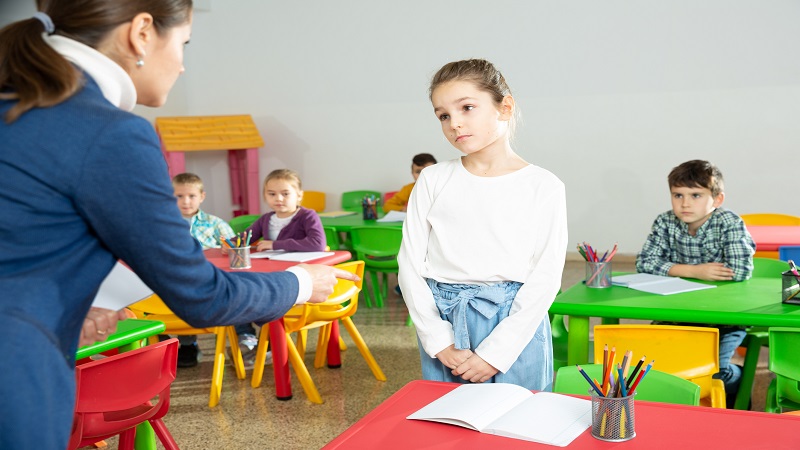
Are you feeling out of control? Perhaps tired, exhausted and hoarse at the end of every day? When shouting becomes your normal, your classroom environment must be improved!
DIFFERENT CLASSROOM ENVIRONMENTS
Take two different examples of classroom environments. Environment A is silent, with every student ‘working’ on something and the teacher is moving around the classroom to check on things. Environment B has all students on task with an element of busy noise from students communicating and collaborating, and the teacher discussing further learning opportunities with their students. From an outside perspective, it may be thought that environment A is supported by a teacher with strong classroom management skills, when in reality it’s environment B!
Although the saying “Give them an inch and they’ll take a mile” may be true, it doesn’t mean you have to go all Mrs Trunchbull on them!
POSITIVE CLASSROOM MANAGEMENT
Classroom management refers to more than simply minimizing distractions and disturbances! It involves creating and maintaining a positive learning environment for all students to perform at their best. When the environment is welcoming, engaging and supportive, little energy will be spent on responding to disturbances.
Creating a positive learning environment encompasses the physical and the social aspects of a classroom:
Physical aspects for a positive learning environment:
1. Decoration
Create an attractive, welcoming environment to suit both you and your students. Whether that’s incorporating bright colors, or calming features, your environment needs to have that feel good factor.
2. Organization
Keep your classroom organized with neat, accessible work spaces so that you and your students can easily find everything needed. Well-organized areas facilitate a calming atmosphere!
3. Supports
Provide well structured supports around the classroom such as working walls to promote independent learning.
Social aspects for a positive learning environment:
1. Connection
Take the time to get to know your students on a personal level. Find out personal aspects and interests to maximize your engagement with them. With student interests known, you can incorporate them into your learning program and find a deeper level of connection that goes outside of the teaching curriculum.
To find out more about building student connections, visit this blog…
https://tru-teach.com/blog/building-student-connections
2. Student Engagement
Provide learning experiences that are purposeful, fun and presented in the real-world to captivate your students’ attention and ensure that they are invested in their own learning. Differentiate your instruction so that every student is appropriately challenged with learning experiences designed for their ability.
For further information regarding differentiated instruction, check out this blog...
https://tru-teach.com/blog/one-size-doesn-t-fit-all
3. Time Management
Plan activities and tasks of high quality and value. Be mindful of your students’ attention spans by limiting your talking time and focus on students’ time to explore and collaborate with their peers.
4. Expectations
Set high expectations for yourself and your students to promote a culture of everyone doing their best. Build whole class routines so that students understand what’s expected of them in the classroom and the school community.
RESPONDING TO CLASSROOM EVENTS/DISTURBANCES
When a positive learning environment is established and maintained, less time, effort and resources will be spent on minimizing disturbances.
Does this mean that classroom disturbances will be eliminated? Absolutely not! No matter how positive the learning environment is, there will still be the need to respond to disturbances, however the frequency and severity will likely be lower. Why? Because we’re all human. We all have good days, bad days and days in between.
When dealing with classroom events and disturbances, a teacher must be able to distinguish between relevant and irrelevant events, decide which require attention and which don’t and respond appropriately (Wolff, Jarodzka, Boshuizen, 2021).
To respond appropriately, teachers must consider the needs of their students and apply strategies accordingly. Many techniques that are often considered supportive for individual students who find classroom environments challenging, are actually beneficial for the whole class!
Here are our top 5 strategies for responding to classroom events/disturbances and how they can be applied to individual students and the whole class…
|
Strategy |
Event/Disturbance |
Individual |
Whole Class |
|
Visual Schedule |
|
Small, moveable pictures on a student board. |
Large, moveable pictures displayed on the class board. |
|
First/then board |
|
Small, moveable pictures on a student board. |
|
|
Timer |
|
Small timer at a student’s workspace. |
Large timer displayed on the board. |
|
Movement breaks |
|
Physical actions/activity to complete in own space. |
Physical actions/activity to complete in large classroom space. |
|
Reward system |
|
Small, personalized chart to communicate between school and home. |
Large classroom chart/system tailored for the class. |
A positive learning environment that nurtures students personally, socially and academically is the key to positively managing any classroom. Remember to be firm yet fair, follow through with your high expectations and be vulnerable with your students to build their trust and respect!
For personalized support with classroom management, from a certified teaching coach, complete our contact form or phone 1-587-625-8510 !
It’s FREE for teachers to access!
References
Wolff, C, Jarodzka, H & Boshuizen, H.P.A. (2021) Classroom Management Scripts: a Theoretical Model Contrasting Expert and Novice Teachers’ Knowledge and Awareness of Classroom Events. Educational Psychology Review, 33, 131-148. Available at: https://link.springer.com/article/10.1007/s10648-020-09542-0 [Accessed 16 November 2022].
Teach. Learn. Breathe. Grow.
Thanks for considering TruTeach for your professional and educational needs.
We'd like to get to know you a little better so that we can focus on your goals.
Please complete the contact form below and a TruTeach professional will reach out to you.
